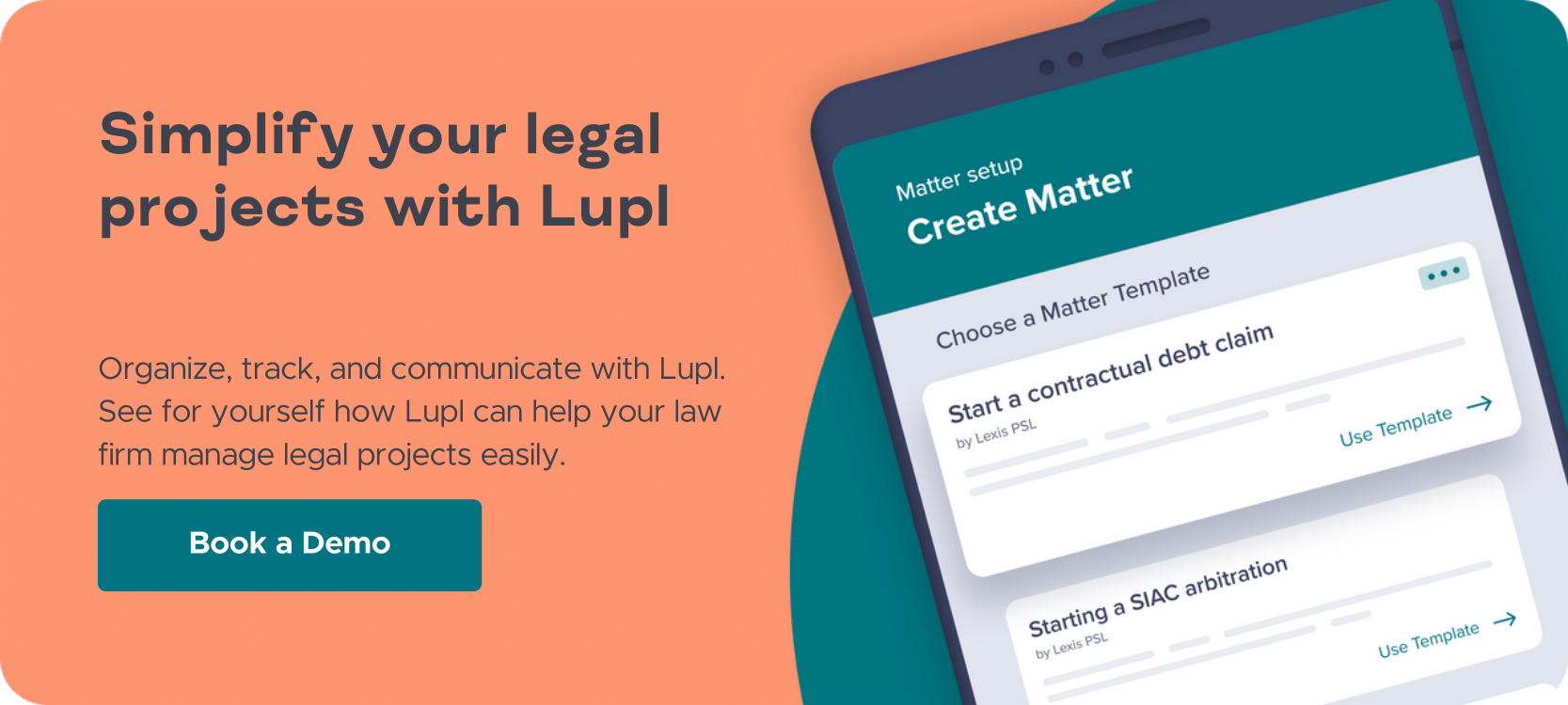Can Legal Tech be Trusted in 2023?

Legal tech. You’ve heard a million times how it’s going to improve the way you work. But in reality, it often does the opposite, inflating your tech stack and making processes more complicated. It hasn’t lived up to its claims, so why trust it?
Because legal has got it wrong. It’s not the fault of tech — more often, it’s the fault of law firms choosing the wrong tech and then using it in the wrong ways. With 60% of surveyed lawyers feeling dissatisfied with their current tech stack, you can see why tech’s got a bad rep.1
The truth is, to remain competitive, keep bringing in talented lawyers, and improve client delivery, the legal industry needs to trust legal tech. In this blog, we’re going to break down why many lawyers don’t trust legal tech, and how they can bring in solutions that can improve their firm’s workflows.
Using the wrong tech tools
You know what it’s like: you get shiny new tools brought in that are meant to ‘streamline your processes’ or ‘cut your workload in half’. But they don’t really work and the problems you have to deal with stay as difficult as before. Why? Because they’re developed by people who don’t do the day-to-day legal work you do and so don’t know the processes that would make your life easier.
So as your tech stack expands with yet another tool, it becomes harder to find what you want in a complex web of information. Although firms get to say, ‘We’ve added new tech!’, sometimes all it achieves is an added headache for their teams.
But it’s not just new tech that’s a problem. You might already be using billing software that isn’t integrated with your systems properly. Or using messaging apps that haven’t been adopted by your whole team, meaning you have to switch from app to app to get basic tasks done. Or work on spreadsheets to ‘manage’ matters.
Faced with a bloated tech stack such as this in 2023, is it any surprise that lawyers don’t trust tech?
Choosing the right tech tools
Improving procurement processes
Finding the right tech can be hard when there’s so much on the market offering different solutions to so many different problems. The important thing is to find the right solution for you. And first things first, your procurement needs to be right.
You do that by getting different people involved. Those generally involved in tech procurement are those higher up, and they’re usually trained in old-school face-to-face processes when tech was less important.
Making sure you involve a wider range of people in the procurement process, including those who are more tech-savvy, will help ensure you get the right tools that people will actually use. And that means…
Selecting tools made by lawyers, for lawyers
Lawyers know the stresses of poor collaboration and unclear communication, so it helps if the tech you use is made by them. You need tech that is actually sector-specific and does what you want it to. This can help deal with issues like:
- Projects can be hard to keep track of: Switching between apps to check if this or that task is done is inefficient and time-consuming. Legal tech with birds-eye view dashboards providing an overview of all your projects lets you keep track of what’s going on and get real-time updates on progress.
- Messy matter management: Starting a new document from scratch each time you set up a new matter is a clunky, non-standardized process. And once it’s set up, it can be hard to get everyone to contribute in a consistent way. Using matter templates helps standardize processes, reduce the risk of missing out important steps, and ensure knowledge is shared and stored in one place.
- Keeping everyone on the same page: When you’re working across platforms and multiple documents, making sure everyone is up to date and has access to the most recent version of documents can be a long process. Live document editing is the opposite: everyone can see updates as they happen and instantly contribute, communicate and collaborate — and keep track of version history.
Doing these things is crucial to maintaining your competitive edge. Law has lagged behind other industries in tech for too long — but not for much longer. Over $1bn was invested in legal tech in 2021, up from $989m in 2019,2 and this number has only increased since then. The law firms that aren’t keeping up or fighting to get ahead of the curve will get left behind.

‘Always on’ tech
Getting the right tech means matter management software that you can access anywhere and at any time. But this presents a challenge in itself:
- On the one hand, using tech that’s more agile and flexible has expanded the reach of what it means to work in law: you don’t need to be in the office all the time to do your job. You can get things done on the go and work from wherever is best for you.
- But on the other hand, it can also mean you’re ‘always on’ — which impacts people’s perception of when they have to be working, and so work-life balance suffers.
Creating a work-life balance
It comes down to how you use the tech, and the culture that surrounds it, which really decides if you’re using tech to actually help lawyers.
This means creating a culture across law firms that’s about using tech efficiently, but not using it all the time. Lawyers are notoriously stressed and burnt out: a shocking 92% have reported experiencing it in their career. This means that tech should be used to relieve rather than ramp up the pressure.
There are a few ways firms can do this:
- Setting limits: Most current software can track who’s using it and when they’re using it — with in-built options for automatic reminders at set time points.
- Checking in: Managers should check in with their team on the projects they’re working on, making sure lawyers aren’t becoming stressed, or rushing work to hit deadlines.
- Breaking down silos: When everyone can access all the knowledge and know-how they need, whenever they need it, it’s a lot easier to get tasks done on time and projects finished ahead of schedule — meaning the stress gets dealt with at work instead of being brought home.
If tech isn’t used in the right way, lawyers will continue to burn out. This leads to increased turnover, maintaining the vicious cycle of burnout and turnover while contributing to a reduced quality of work. This means creating a culture across law firms where tech is used efficiently, but not used all the time. To perform as best they can, lawyers need their downtime too.
‘Garbage in, garbage out’
You can have the most sophisticated tech stack in the world but if you’re not putting in the right data or haven’t been shown how to use it efficiently, the output will be bad too.
It’s easy to blame tech for this, particularly if it’s new tech and you’re expecting better outcomes and increased efficiency. But think of it this way; if you put the wrong fuel in a car and it splutters to a halt, would you blame the car?
Learning what’s garbage, and what’s gold
Make sure you’re using the right data. There’s a lot of data out there and it’s growing year after year. With a growing tech stack too, it might feel like everything’s becoming slightly overwhelming. As data-driven decision-making becomes more important, firms have to make sure the data is good in order to make good decisions.
This means law firms need to use data in the right way, including:
- Keeping it organized: Without proper storage and organization of your data, it can get muddled and confused. Muddled inputs mean muddled outputs. Legal project management tools are all about organization. With advanced subfolders to keep documents and information neat and accessible and matter templates to keep all information about a matter in one place, you can keep everything organized and manageable.
- ‘Minimizing’ your data: Data minimization, the process of keeping the data you store to a minimum, is a growing trend. By limiting the data a law firm holds to just the most important information, it’s easier to make sure that the right data is used, saves time and money by reducing the amount of information that needs to be sifted through and can reduce the likelihood of a law firm data breach.
Pro tip: There are a lot of legal tech companies out there, but here are a few of the best legal tech startups you should know about.

Risk vs. reward
Risk mitigation is always front and center for lawyers and law firms. It’s crucial they’re able to defend their decisions, including on what tech gets brought in. If something goes wrong or if they make an error, they could get sued. The risk-to-reward ratio is high, which means that a lot of the time it feels like it’s better to stick with the tech that you know, rather than trust something new.
There can sometimes be a sense of loss of control by bringing in new tech – especially when that tech is now making decisions for you.
High-reward, low risk
Improving accuracy
When it comes to law, it isn’t technophobia to be worried about what could go wrong when the stakes can run so high. So long as law firms properly document their procurement, implementation and workflow process, while explaining their decisions, then they’ve met their fiduciary responsibility.
That’s why using legal tech is so important: it helps reduce human error. Think about it: manually creating tasks and keeping communication (particularly emails) organized makes errors more likely. But by using tech to create standardized matters, file emails or organize information, all with the touch of a button, there’s less room for error. Unlike people, technology doesn’t accidentally skip a line of information because they’ve had a long day.
And not only does it help improve accuracy, but reducing tedious manual processes also helps you save time — in fact, Lupl helped one firm get 40% of their time back.
Enhancing security
New legal tech also helps mitigate security risks, helping you reduce the risk of data breaches and stay security compliant.
- SOC2 compliant: Billing tools, which contain protected client data, often aren’t integrated properly with the rest of the legal tech stack, leading to potential security weak spots. That’s why SOC2 compliant legal tech is fully encrypted and sector-secure, bringing robustness and sophistication to your firm’s security.
- Reducing vulnerabilities by integrating apps: Messaging tools like WhatsApp can be secure, but if they’re not integrated with your other tools, the disconnection can lead to security vulnerabilities. By using a unified platform that brings together all the various methods of communication people use, end-to-end security is enhanced when communicating with your team and between teams.
- Made in a ‘Security by Design’ framework: Many firms continue to use technology that isn’t designed with security in mind. Email, still one of the main methods of communication in law firms, is one of the most common weak links in the tech stack that can lead to a data breach. Purpose-built for security rather than attempting to add it on at the end, new legal tech highlights how easy communication and knowledge sharing can be when it’s done properly.
Pro Tip: Billing data and information is incredibly sensitive. Lupl’s biggest ever feature update integrates with Clio, allowing you to bring Clio’s financial and billing data into Lupl easily — and securely.
Legal tech you can trust
It’s no surprise many lawyers don’t trust legal tech. They’ve been given the wrong solution for years. But it’s not the fault of tech, but simply law firms not choosing the right tech.
Lupl is a legal project management software, built for lawyers, by lawyers. SOC2 compliant, with open APIs to allow you to integrate all your apps into one unified platform, Lupl brings everything together in one place and helps legal professionals to:
- Streamline communication and collaboration
- Track progress through matter templates and dashboards that give lawyers a bird’s-eye view of their legal projects
- Enhance your security through compliance standards and integrations
- And put your firm at the cutting edge of legal tech adoption.
Streamline your law firm’s processes, organize your information and enhance security by trusting in legal tech. Book a demo today.

1 2022 Attorney Technology Satisfaction Survey | Dashboard Legal
2 Why are investors pouring money into legal technology? | Financial Times
More legal tech insights we think you'll love

Q2 2024 Product Update – New Features & Improvement
Lupl is the leading task and project management solution for...

How a team of trainee lawyers streamlined work handovers with Lupl
CMS trainees adopt Lupl's task management tools to enhance work...

